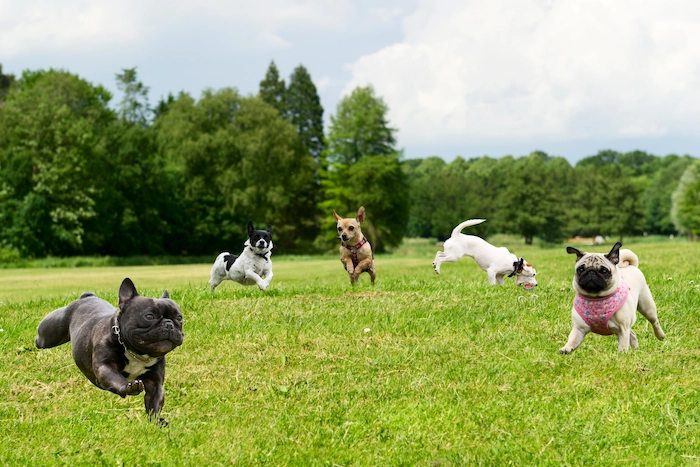
Dog training collars are tools used to help you correct bad behaviors and reinforce good ones. When used with a leash, training collars also keep your pet safe while on walks and out of danger by preventing them from running off. Whether you want to teach your dog to walk on a leash with you or to obey commands, a training collar is a must-have. From e-collars and shock collars to flat collars and prong collars, there are plenty of types to choose from to help you promote positive behaviors in your pet.
Understanding Different Types of Dog Training Collars
There are several types of dog training collars, each with its own pros and cons.
Flat Collars
Many dog owners have used a flat collar. It goes around your dog’s neck like a belt and has a D-ring for holding identification tags.
Flat collars have several advantages worth considering. First and foremost, they are highly affordable and straightforward to utilize, making them a practical choice for many dog owners. Additionally, these collars are well-suited for regular, everyday wear, ensuring that your dog remains comfortable throughout the day. However, it is crucial to acknowledge a couple of potential drawbacks. When it comes to pulling, there is a risk of injury to the dog, so it’s important to be cautious and mindful during walks. Another concern is that flat collars can be relatively easy for a dog to slip out of, necessitating extra vigilance and secure attachment.
Martingale Dog Collars Martingale collars are a combination of a slip collar and a flat collar. When your dog is calm and at rest, the collar sits comfortably on its neck. When they start pulling, the collar gets tight, but there’s a limit to how tight the collar gets. Once the dog relaxes, the collar loosens.
Martingale collars offer several advantages, including their affordability and user-friendly nature. These collars are also adjustable, allowing pet owners to find the perfect fit for their furry companions. However, it’s important to note that an improper fit can potentially lead to injuries. It is crucial for pet owners to ensure that the collar is properly fitted to prevent any harm to their pets.
Prong Collars
Prong collars, or choke collars, have no limit to how tight they get. The side facing the dog’s neck has prongs that dig into the skin to get the dog’s attention when tension is applied. Like the Martingale, a prong collar releases its tension when your dog is relaxed.
On the positive side, prong collars are particularly effective for large and strong dogs, effectively addressing aggressive behaviors like lunging and jumping. However, there are drawbacks to consider. Prong collars can be challenging to use properly, requiring knowledge and skill to ensure they are not used incorrectly. Additionally, these collars should only be used for short periods, as prolonged use can cause discomfort or potential harm to the dog.
Electronic Dog Collars
Electronic dog collars send a mild electronic current through metal components on the underside of the collar to help encourage good behaviors. However, unlike traditional electronic dog collars, Halo Collar feedback provides a sense of “touch” that feels like a tap on the shoulder for your dog. This interrupts your dog’s fixation in dangerous situations and distraction-filled environments to keep them out of harm’s way.
Electronic collars have several advantages that make them a preferred choice for dog owners. They are particularly effective for obedience training, providing a reliable and efficient means of communication between the owner and the dog, even over longer distances. Additionally, electronic collars offer an added layer of safety for dogs. However, it is important to consider the drawbacks as well. These collars tend to be priced higher compared to traditional flat dog collars, making them a more expensive option. Furthermore, using electronic collars requires proper training to ensure their effective and humane use.

Choosing the Right Collar for Your Dog
With so many options to choose from, picking the best training collar for your dog can be a confusing task. Training collars help you effectively communicate with your dog during training sessions, and because not all dogs learn the same way, what works for one may not work for another. There are several things to consider when choosing a collar.
Your Dog’s Size and Breed
Head shape, neck size, strength, and weight are all factors to consider when choosing a collar. To ensure a proper fit, use a tape measure to measure your dog’s neck where the collar sits. Slide two fingers between your dog’s neck and the tape measure so the collar is a few inches larger than your dog’s neck. The extra room ensures a proper fit.
Training Needs
Consider your dog’s specific training needs when purchasing a collar. Prong collars offer greater control for dogs that like to lunge and pull, while flat collars are ideal for basic obedience and perfect for smaller dogs. Electronic collars address behavior modification issues and help with advanced training.
Setting Up Your Dog’s Training Collar
Start by placing the dog collar around the center of the dog’s neck. A properly fitted collar is crucial for your dog’s comfort and the collar’s effectiveness. The collar should be snug enough to stay in place but loose enough for you to slip two fingers between the collar and your dog’s neck comfortably. Adjust the strap accordingly and check the fit regularly to ensure it remains comfortable as your dog grows or changes weight.
Next, if you’re using an electronic collar, it will likely have adjustable intensity levels. It’s crucial to start with the lowest level and only increase if necessary. The correct level should just get your dog’s attention without causing any discomfort. Alternatively, if you’re using a Halo Collar, audible feedback serves as a gentle and effective training tool.
Introducing the Collar to Your Dog
Before using the training collar for training sessions, allow your dog to get used to wearing it. Start by having your dog wear the collar during positive experiences, like during meal times or play. This way, your dog associates the collar with positive experiences.
Once your dog is used to the collar, you can begin using it for training. Always start training in a quiet, familiar environment to minimize distractions. Use the collar as a tool to reinforce commands your dog already knows, not as a way to introduce new ones.
Dog Training Techniques and Tips
In obedience training, dogs are initially taught five basic commands: sit, stay, down, come, and heel. Regardless of what type of training collar you use, communicating the command and providing positive reinforcement are important to the success of the training program. Dog training should be fun for both you and your pet, and if you’re approaching the task correctly, your dog will be eager to learn and please you.
When teaching basic commands, be generous with your praise. Provide treats or give your dog its favorite toy. It’s also important to have realistic expectations. Just like people, each dog learns at a different pace. As long as your pet continues to try, continue praising and reinforcing the good behavior.
Be consistent with your training. If you’re teaching your dog to stop jumping on people, correct it every time it jumps. Reward it when it doesn’t jump, but provide a stern “no” each time it does or immediately send electronic stimuli with an e-collar. Inconsistency will confuse your pet.
If you sign up for obedience classes, your professional trainer will know how to gauge your progress and when to introduce new skills. If you’re training your pet by yourself, keep a journal of its progress. Adjust your expectations as needed to avoid stress. It’s better to introduce a new skill once or twice a week rather than every day. Don’t introduce new skills until you’re sure your pet has the current one down. It’s also important to review old skills.
Safety Precautions and Potential Risks
When used inappropriately, any training collar, including electronic collars, can cause stress. You can avoid this stress when you learn to use the dog training collar correctly. Always keep the collar at the lowest setting. Corrections should only cause a slight reaction and not cause physical pain. If your dog is responding with fear or aggression or not listening at all, you may need to seek the advice of a professional dog trainer.
When training, make sure you’re not overcorrecting. If you’re using an electronic collar to reduce barking, your dog won’t stop barking completely. Punishing innate behaviors causes stress. Also, be sure you’re correcting bad behavior within a few seconds of it occurring. Otherwise, your pet won’t understand why it’s being corrected. Unlike traditional “shock collars,” Halo Collar utilizes innovative technology that focuses on audible cues and haptic feedback, meaning you can customize the collar to what your dog responds to best.
When used the wrong way, a traditional e-collar can change your dog’s personality and temperament and cause it to be fearful of you. However, the Halo Collar’s focus on audible cues helps maintain a positive relationship between you and your furry companion. By associating the beep with guidance and reinforcement rather than pain, the Halo Collar promotes a more harmonious training experience.
The Rise of GPS Dog Collars

More and more dog owners are using GPS dog collars. In recent years, there has been a significant increase in the popularity of GPS collars as a means of ensuring the safety and security of our beloved furry friends. According to a survey conducted in 2018, approximately 15 percent of dog owners surveyed stated that they had purchased a GPS collar for their dogs. This number has continued to grow as more pet owners recognize the benefits of using GPS technology to track their dog’s whereabouts. With the advancement of GPS technology and its increasing affordability, GPS collars like Halo Collar have become a practical and humane solution for pet owners seeking peace of mind and added security for their canine companions.
Conclusion
Dog collars are important training tools to reinforce good behavior and rid your dog of unwanted behavior. Knowing which one is best for your pet is the first step in a successful training program. For an all-in-one training solution, Halo Collar is effective in keeping your pet on your property, for off-leash training, and for teaching basic commands. With Cesar Millan’s dog training expertise, you can teach boundaries and build a stronger and healthier relationship with your pet.






